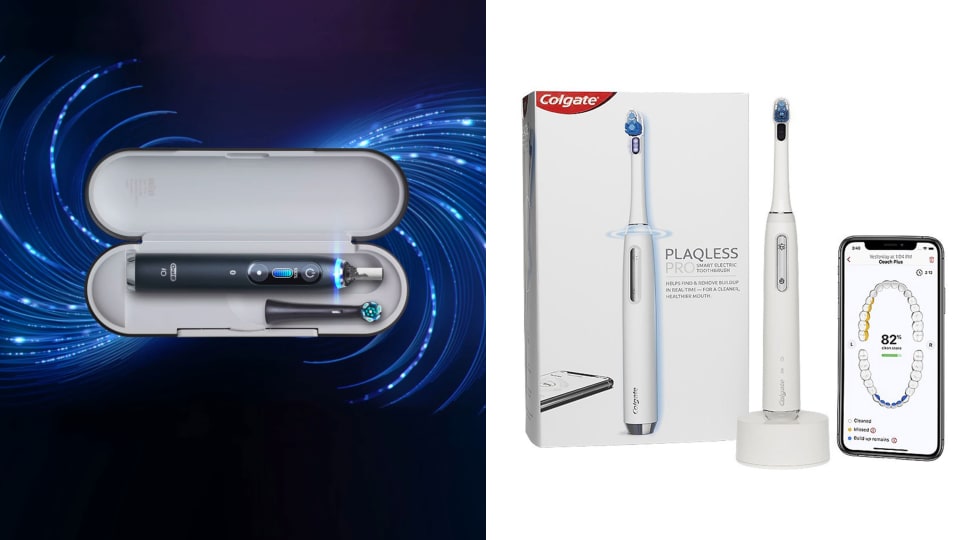How high-tech does a toothbrush really need to be?
We don't brush our teeth very well. Technology wants to help.
 Credit:
Oral-B / Colgate
Credit:
Oral-B / Colgate
Products are chosen independently by our editors. Purchases made through our links may earn us a commission.
Dental care has come a long way since we were first using bone and hog hair brushes in sixth-century China, but based on some of the raised eyebrows I've seen at the CES electronics show this week, some might argue that the pendulum has swung too far in the other direction.
Oral-B and Colgate, two household names in oral hygiene, each released state-of-the-art toothbrushes that promise to get your teeth cleaner than a standard brush. They join the ranks of dozens of other "smart brushes" that sport a list of features rivaling some laptops, which of course begs the question, "why?" Aren't we fine with toothbrushes as they already are?
As it turns out, no. But the problem isn't the brush. It's us, and better toothbrushes can address routine mistakes that we make as caretakers of our dental health.
We don't brush very well
The sad fact is that most people are simply not very effective brushers. We're lazy, spending less time that we ought to. Even when we do spend enough time, we're frequently using the wrong movement, hitting the wrong spots, and applying the wrong amount of pressure.
A standard, unplugged, three-dollar toothbrush won't offer much help with these shortcomings. And the fact that, at best, you're only seeing a dental professional every six months, leaves a lot of time to accumulate problems like plaque and sore gums.
Electric toothbrushes—and more recently, smart toothbrushes—can provide real-time feedback on how to improve. Just be prepared for a bit of a learning curve and, of course, paying for the privilege.
The dentists' plea: Two minutes of brushing, twice per day
In a way, dentists are the chief witnesses to our best intentions falling short of the mark. Of course we mean to floss and brush, avoid excessive sweets, and the rest of the periodontal litany. But we're human.
That's why dentists, ever the pragmatists, just want us to brush two minutes per day, twice per day. That's it. If we can manage that simple (yet somehow elusive) routine, we can expect decent results.
As such, there's a two-minute timer on most mid- to high-end electric toothbrushes. Fancier models break it up into four 30-second intervals to match the "four quadrants" of your mouth.
If nothing else, the timer is the single most compelling argument to buy an electric toothbrush. Everything after that is, in a certain sense, gilding the lily. And boy, there can be a lot of gilding.
Smart toothbrushes, and too-smart toothbrushes
Oral-B—as well as its primary competitor, Philips Sonicare—makes a wide range of electric brushes, from the basic to the ultra-premium. But there are always greater horizons in the premium market, as evinced by the new Oral-B iO.
The iO is a Bluetooth-connected toothbrush that syncs with the latest version of its smartphone app. Using accelerometers in the handle, the brush is able to map your mouth as you brush across six zones (not just four), including front, back, and the bite. Visual feedback on the screen lets you know just how long to spend in each area before moving on. To avoid gum issues, the handle also lights up green to indicate when the correct pressure is being applied, and red when it's excessive.
A great deal of attention has been paid to the design of this brush. It emphasizes positive feedback and rewards you with little trophies for hitting goals. The inside of the handle is no doubt a model of modern computer engineering, and it features an all-new magnetic drive system to rotate the bristles. It may well be the pinnacle of toothbrush engineering. And it is all a little overwhelming.
Personally, I don’t want to deal with the dental equivalent of a flight simulator at the end of a long day. I've tested many of the smart toothbrushes on the market, and my opinion has not changed, despite technological advances. So if you're choosing an app-based toothbrush, understand that while it's an attention-grabbing feature, the novelty may wear off sooner than you think.
Putting a flashlight on plaque
There are intelligent approaches to a high-tech brush that don't require juggling a smartphone in your other hand. The new Colgate Plaqless Pro, for example, emits a blue light from just under the bristles. The specific wavelength of light excites the porphyrin, a component in the bacteria that causes plaque, causing it glow with natural luminescence. If the bacteria is detected, the barrel of the toothbrush also glows, letting you know to keep brushing in that spot until it's gone. While the Plaqless Pro does connect to a Colgate app, the plaque-detection feature works fine without it, so your brushing routine can be both innovative and pragmatic.
So if you're looking for a better clean, it might be time to finally upgrade your brush. Your dentist will thank you. But as with most new gadgets, avoid picking the top-of-the-line model and be wary of features you don't understand.


